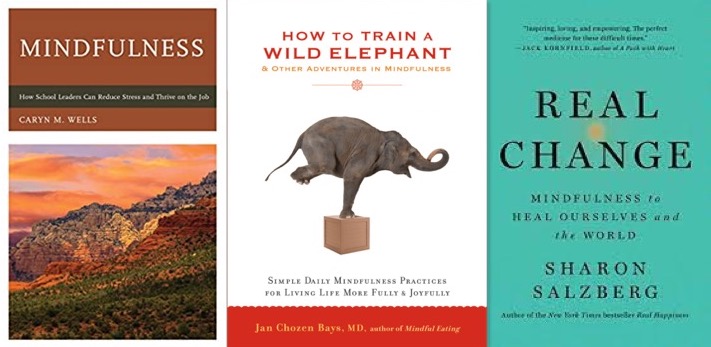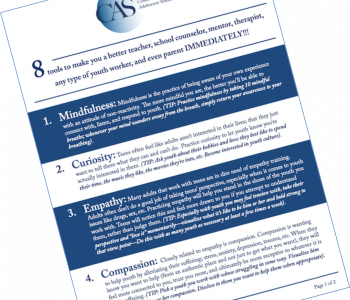

Catharine Hannay, MA
Catharine Hannay is the founder of MindfulTeachers.org and the author of Being You: A Girl’s Guide to Mindfulness, a workbook for teen girls on mindfulness, compassion, and self-acceptance.
4 ‘Must-Read’ Books about Mindfulness
There’s so much being published about mindfulness these days that it can be overwhelming trying to sort through all the different options. Of the dozens of books I’ve read over the past few years, here are four that I think are particularly useful for the helping professions.
How to Train a Wild Elephant, & Other Adventures in Mindfulness
by Jan Chozen Bays, M.D.
I’d recommend How to Train a Wild Elephant to anyone who wants to jump right into a mindfulness practice without a lot of theory.
It could also be a great resource for mindfulness teachers who are looking for creative new approaches. For example, there are three different practices that focus on the hands, as well as five different approaches to mindful eating.
One of my favorite practices is called Entering New Spaces, also known as “mindfulness of doors.” Apparently I’m not the only person who bumps into doorways when I’m tired or preoccupied?
“Don’t be discouraged if at first you don’t succeed in carrying out this task. It is one of the most difficult tasks we’ve undertaken at the monastery over the years. You find yourself walking toward a door, thinking ‘Door, door, be mindful walking through the…’ and suddenly you find yourself on the other side of the door, with no awareness of how you passed through it. […] One person used a counter to keep track of the number of doors he passed through—over two hundred forty in one day! That’s a lot of potential mindfulness moments. […] Another person, who had a lifelong habit of slamming doors, worked on closing doors gently.” (p. 81)
As you can see in the above quote, Dr. Chozen Bays mentions experiences at her Zen monastery, but without implying any particular set of beliefs. (In fact, Zen is often considered more of a philosophy than a religion.)
Mindfulness: How School Leaders Can Relieve Stress and Thrive on the Job
by Caryn M. Wells
Caryn Wells describes the characteristics of people with the ideal combination of high levels of mindfulness and highly-developed leadership skills:
- compassionate;
- listening to hear;
- being fully present in the moment;
- letting go of issues that need to be forgotten;
- responding instead of reacting to issues;
- resisting the urge to interrupt or dominate tense conversations;
- building trust by their demeanor (p. 10; 38)
She includes an overview of key research on the benefits of mindfulness for leaders, then delves into advice on coping with stress, conflict, and burnout.
“Most leaders have not been prepared for the onslaught of problems they will face in the workplace. […] By being fully present and developing mindfulness practices, stress can be reduced and leadership effectiveness increased.” (p. xxi-xxii)
In addition to school leaders, I’d recommend this book to anyone in an administrative or supervisory role at your institution. The charts and worksheets could also be useful in training and professional development.
The Mindful Christian: Creating a Life of Intentionality, Openness, and Faith
by Dr. Irene Kraegel
You may be surprised that I’m recommending a book about Christian mindfulness. I decided to include it because I’ve seen so many misunderstandings (including lawsuits!) between Christian parents and secular mindfulness teachers. For example, a lot of Christians resist lovingkindness meditation and the concept of ‘nonjudgment,’ and aren’t convinced by explanations based on Buddhist traditions or brain scans.
Dr. Kraegel teaches mindfulness at a faith-based college and has done a lot of reflection on how to integrate what she learned in her mindfulness training with her beliefs as a Christian. She describes her initial discomfort with lovingkindness meditation, which she now embraces as a type of intercessory prayer. And here’s her explanation of nonjudgmental awareness:
“Letting go of judgment does not mean abandonment of wise discernment. […] We want to make our words and actions count. We want to choose the right battles and make the right truces. A mindful, nonjudgmental stance cultivates the presence of mind needed for sound judgment and action.” (p. 101)
Dr. Kraegel also includes Mindfully Meditative Christian Practices: “while not identical to traditional, formal mindfulness practice, they have significant overlap with the practice of mindfulness meditation.”
Real Change: Mindfulness to Heal Ourselves and Our World
by Sharon Salzberg
Sharon Salzberg is co-founder of the Insight Meditation Society. There are frequent references in Real Change to “Buddhist psychology” but nothing that implies a particular set of beliefs. Salzburg says she wrote the book to: “explore the intersection between the activity of working to change in the world and the clarity and compassion arising from mindfulness and lovingkindness practice.” (p.3)
“We all struggle with what to change and what to let be, what we can affect and what we can’t, the effort it takes to foster change, and how it’s all too possible to burn out or shut down. I’ve learned that meditation can provide tools to help courage grow out of rage and resilience out of grief.” (p. 3)
According to Salzburg, mindfulness and lovingkindness help us to:
- build a quality of resilience that can shore us up for the long haul;
- clear our minds to make better choices, with strategies based on the values we want to live by;
- be with our feelings of loss or frustration or pain in a way that’s healing and onward leading, instead of devastating;
- focus our energies more productively and relieve the exhaustion of finding too many battles to fight;
- join forces with others more effectively and harmoniously;
- transform how we see ourselves, those we work with, and those whose decisions and actions we work against; and
- lighten and open our hearts as we cultivate the power of connection. (p. 21-22)
“I would never suggest meditation […] as a replacement for action. But I know I need to connect to something bigger, repeatedly, to have energy to keep acting.” (p. 23)
I hope you find these suggestions useful for your personal practice and in your work with youth. You can find more recommended books in the following posts:
- 4 ‘Must-Read’ Books If You Care About Teens
- 4 ‘Must-Read’ Books for Professionals Working with Traumatized Youth
Also, Dr. Sam Himelstein, director of the Center for Adolescent Studies, has a series of professional development books on sharing mindfulness with youth:
A Mindfulness-Based Approach to Working with High-Risk Adolescents
Trauma-Informed Mindfulness with Teens: A Guide for Mental Health Professionals
And my own book Being You: A Girl’s Guide to Mindfulness helps teen girls develop mindfulness and self-acceptance. There are 52 different activities, including fun ways to explore the five senses, breath-based meditation for handling stress and anxiety, and reflective worksheets on reaching their goals and helping their communities.

